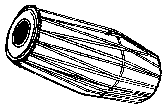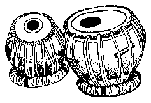The Bansuri is a deceptively simple bamboo flute. The Indian-style flute uses no keys, tone control being a matter of breath control and careful fingering on the six or seven holes in the flute. The bansuri is one of the recent additions to classical music in India, having been traditionally regarded as more of a folk instrument.
 Bin (Rudra Vina)
Bin (Rudra Vina)The Bin is one of the oldest instruments in Indian music. Technically a stick zither, it consists of a fingerboard with two large gourd resonators at either end. The Bin usually has four main playing strings, and two or three "chikari" strings used as rhythmic drones. It is used primarily in performance of Dhrupad, and as such is rather rare.
An instrument introduced by the British, the harmonium is like a small pump organ. It is almost never used as a solo instrument, being much more common as an accompaniment for a vocalist. Some musical purists object to it because it cannot reproduce the subtle changes of intonation that are necessary in Indian music.
 Santur
SanturAnother instrument which until recently was used mainly for folk music, the santur is the Indian version of the hammered dulcimer. The classical version has 84 strings. It is traditionally associated with the province of Rajasthan.
 Sarangi
SarangiThe sarangi is the principal bowed instrument in modern Hindustani music. A typical sarangi has three main playing strings, and from 35-40 sympathetic strings. Although traditionally used mainly to accompany singers, it is gaining a reputation as a solo instrument.
 Sarod
SarodOne of the two main plucked string instruments in Hindustani music, the sarod is a fretless instrument with (usually) 25 strings. Of these 25, fifteen are sympathetic strings, and six more are tuned to various drones, leaving four main playing strings. It is played with a plectrum made out of a piece of coconut shell.
The Shehnai is a double-reed wind instrument (like an oboe). Traditionally it was used mostly for outdoor celebrations, and for temple music. More recently it has been used as a concert instrument as well.
 Sitar
SitarThe sitar is probably the best-known of the instruments of India. It is a long-necked plucked lute, typically with about 18 strings (11 sympathetic, 3 - 5 drone strings, and 2 - 4 playing strings). As it is fretted, the complex ornamentation of Indian music is produced by pulling the string sideways along the fret.
The surbahar is similar to the sitar, but larger, and with a deeper tone. It is used in some of the same contexts as the Bin, and is also a rather rare instrument.
 Pakhawaj
Pakhawaj Tabla
Tabla